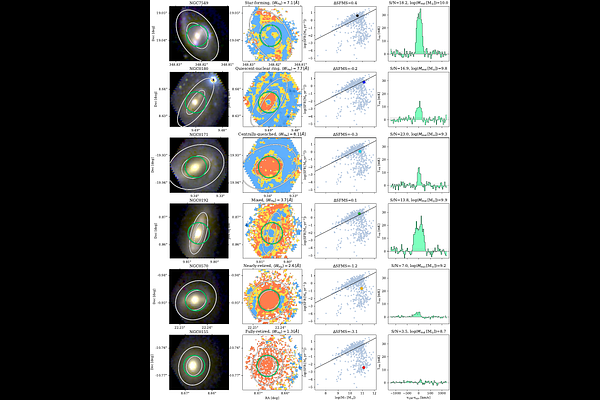The EDGE-CALIFA survey: Star formation relationships for galaxies at different stages of their evolution

The EDGE-CALIFA survey: Star formation relationships for galaxies at different stages of their evolution
D. Colombo, V. Kalinova, Z. Bazzi, S. F. Sanchez, A. D. Bolatto, T. Wong, V. Villanueva, E. Rosolowsky, A. Weiß, K. D. French, A. Leroy, J. Barrera-Ballesteros, Y. Garay-Solis, F. Bigiel, A. Tripathi, B. Rodriguez
AbstractGalaxy evolution is largely driven by star formation activity or by the cessation of it, also called star formation quenching. In this paper, we present star formation scaling relations for galaxies at different evolutionary stages. To do so, we used the integrated Extragalactic Database for Galaxy Evolution (iEDGE), which collects CO, optical continuum, and emission line information for 643 galaxies from the CALIFA IFU dataset. By considering the patterns described by star-forming and retired regions, we grouped the galaxies into quenching stages using the emission line classification scheme, QueStNA. We observed that the molecular gas mass ($M_{\rm mol}$) decreases from star-forming to retired systems and so does the molecular-to-stellar mass ratio ($f_{\rm mol}$). In contrast, star formation efficiency (SFE) is constant in the quenching stages dominated by star formation and rapidly declines afterwards. We observed that this rapid decline is more pronounced in the centre of the galaxies compared to the rest of the discs, reflecting the inside-out quenching displayed by nearby galaxies. We noticed that the relations between $M_{\rm mol}$ and the stellar mass ($M_*$) become increasingly shallow with the quenching stages; however, the relations between the star formation rate (SFR) and $M_{\rm mol}$ steepen when going from star-forming to retired systems. We observed that a three-dimensional relation between SFR, $M_*$, and $M_{\rm mol}$ exists for star-forming galaxies, while data points from other quenching groups are scattered across the parameter space. Taken together, these pieces of evidence indicate that the quenching of the galaxies cannot be explained solely by a depletion of the molecular gas and that a significant decrease in the SFE is necessary to retire the centre of the galaxies beyond the star formation green valley.